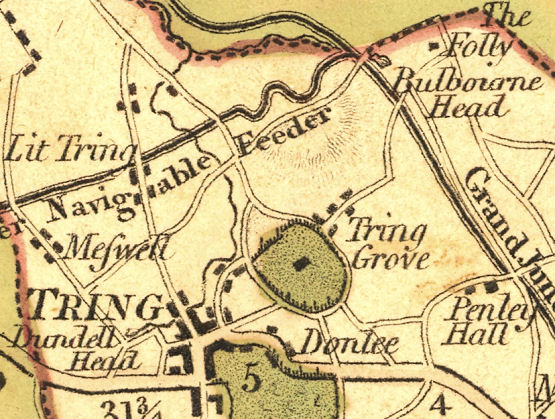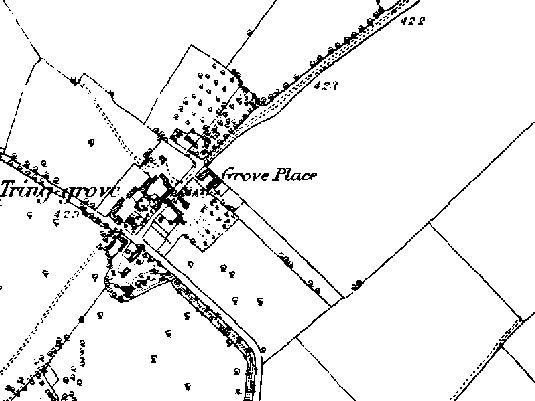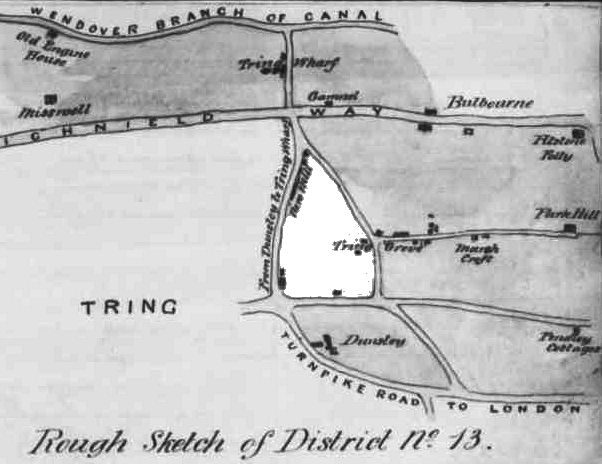|
Lord LAKE & Sale of Tring Grove Estate, 1854 |
|
Notes on entries in William Brown's Account Book
William Brown's Account book contains 4 folios relating to the sale of the Tring Grove Estate, which had been owned by the late Lord Lake, of Aston Clinton. There had been a dispute over the estate in the High Court of Chancery, and the sale was being carried out with the approval of the Vice Chancellor of the Court, Sir Richard Torin Kindersley.
The purpose of this exercise is to demonstrate the kinds of information available if you want to research a the history of a small estate and provide a framework for further research. At present I don't have the time to take matters further - but welcome comments and suggestions - and if the opportunity arises when I am visiting a relevant archive I may collect and add more information.
TOPIC HEADINGS
Tring Agricultural Association Minute Book
Identification of the Properties Sold
Folio 106 Starts on 1st November, 1852 with the first of a number of trips to London to make arrangements for the sale, making surveys, and placing preliminary advertisements.
Folio 148 Relates to arrangements for the sale, including the decision to hold the sale in London, preparation of the brochures, estimating the reserves on the various lots, etc.
Folio 149 Relates to the costs of the sale, commission, arrangement after the sale relating to timber on the lands, and other expenses relation to advertising and producing 300 plans (by Mr Bird) for the brochure.
Folio 150 relates to the sorting out of copyhold property, and a dispute (over title?) with Baron Rothschild about Cutler's Close (location unknown) but may have related to property purchased by a Mr Horwood. William Brown's bill was finally settled by Messrs Currie, Woodgate & Williams for £208 17s 2d on 14th August 1855.
The title Viscount Lake, of Delhi and Laswary and of Aston Clinton in the County of Buckinghamshire was created in 1807 for the soldier George Lake, who was Member of Parliament for Aylesbury from 1790 to 1802 and commander in chief of India between 1801 and 1807. The First Viscount died in 1808, to be succeeded by his son Francis Gerald Lake, who died in 1836 and was succeeded by his brother Warwick Lake, the 3rd Viscount, who died in 1848, the title then becoming extinct. The house at Aston Clinton was purchased by Sir Anthony de Rothschild in 1851. The sale of the Tring Grove Estate relates to the dispute over the will of Warwick Lake. who had several children by his mistress.
It should be noted that HALS holds a large bundle of documents, Ref DE/LS/T152, which includes information on land in Tring and Wigginton and "papers in Chancery case between Sarah O'Hara, heiress of Lord Lake, and others, concerning the trust of Tring Grove Estate, bills of complaint, cases for opinion and copy of letters patent granting title." Obviously a full follow up would involve a study of these documents but for the time being I will simply summaries some of the information immediately available to me.
|
|
|
|
|
Bucks Herald 13th August 1853 (and elsewhere) |
Herts Mercury 10 September 1853 |
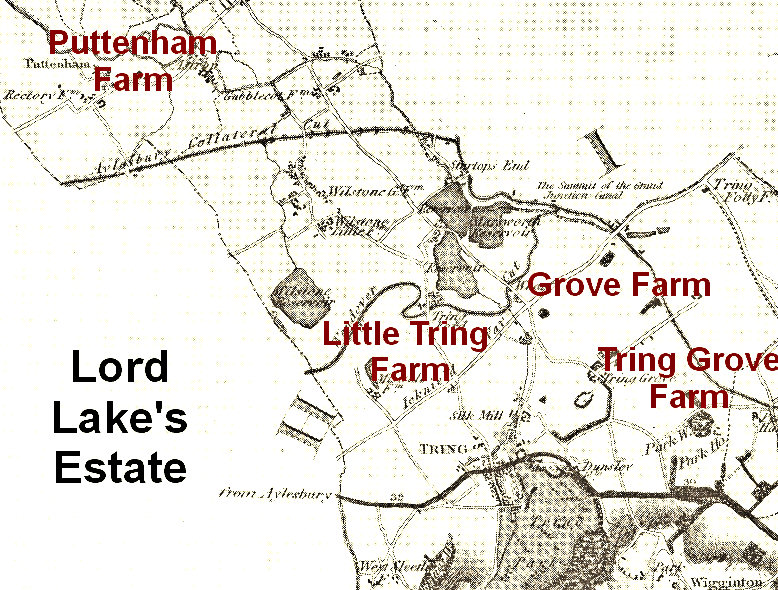
Printed Maps Showing Tring Grove
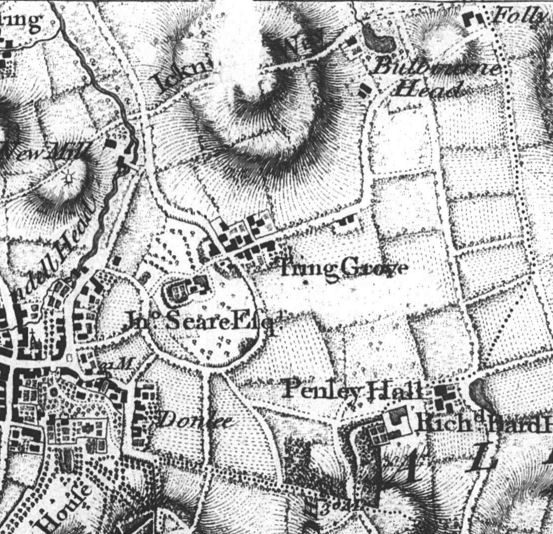 |
Map of 1766
This shows the area before the building of the Grand Junction Canal. While few of the actual buildings survive today the hamlet of Tring Grove is still identifiable at the west end of what is now Marshcroft Lane. There is still a separate group of houses on Marshcroft Lane.
The map shows a separate large house and park occupied by John Seare, Esq.
|
|
|
|
Charles Smith's map 1808 edition
This was a smaller scale, and in part redrawn, from Dury and Andrews' map. The canal has been added but not very accurately, as for example, it fails to show the significant meander at Little Tring.
John Cary's map of 1811 is effectively identical in showing an estate at Tring Grove and a wrongly positioned canal. |
|
|
|
Bryant's map of 1822
This was definitely the result of a new survey and correctly shows the course of the canal.
Interestingly it shows a strip of woodland marking the south and east boundaries of the park shown in the earlier maps. There is an enclosure where the house was shown in earlier maps, but no obvious indication of a significant building. |
|
|
|
Ordnance Survey 1888
This is the first really large scale published map of the area, after the railway line had been built, and I only show a detail.
It is clear that the big house shown in the earliest maps has gone, but another smaller one, Grove Place, has appeared in Tring Grove hamlet. |
|
|
|
Ordnance Survey 1898
This is from the 1 inch map to provide an overview with the canal, the railway, the "new road between Tring and the Station bypassing Pendley, and the houses built along Station Road, the biggest being Beech Grove. |
|
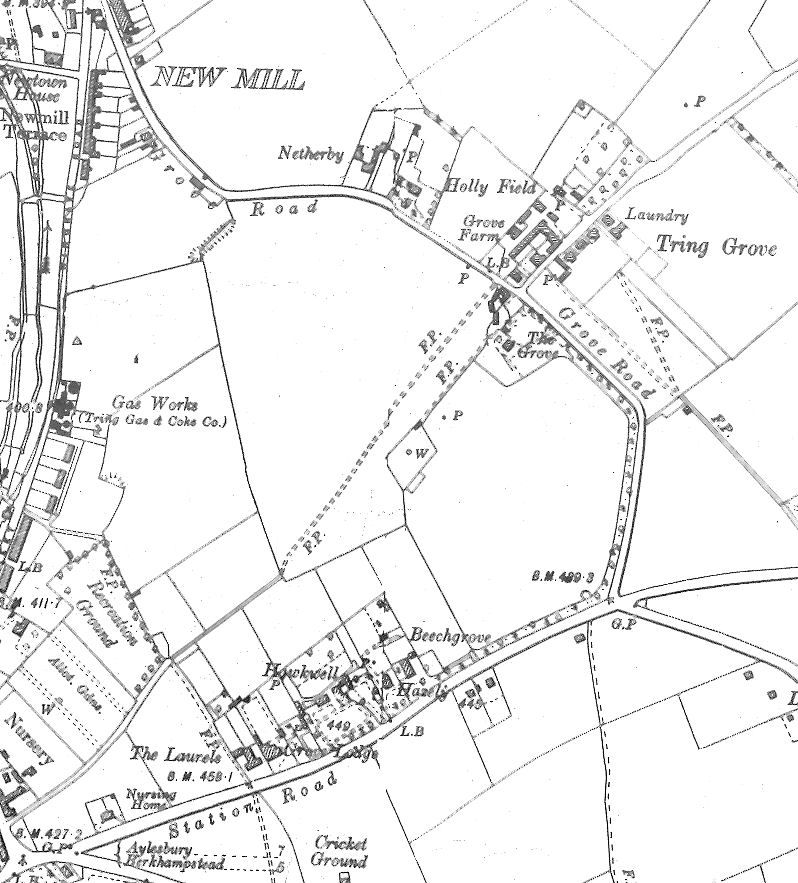 |
Ordnance Survey c1930 |
There is no mention of Tring Grove or Grove Park in Chauncy's (1700), Salmon's (1728), Clutterbuck's or Cussans' (1879) Histories of Hertfordshire - all of which concentrate on manors, and tend not to mention non-manorial houses and estates. The Victoria County History for Hertfordshire simply refers to Tring Grove as a hamlet. None of the owners or occupants feature in Wendy Austin's Tring Personalities books, and most of the other recently published books are collection of photographs and don't contain any significant earlier detail. However A History of Tring by Sheila Richards includes an appendix Valuation of property in the Parish of Tring made by the Commissioners under the Inclosure Act (1797) which record the following property owned by Mrs Harriett Seare
| Property | Occupier | |
| Mansion | Rt. Honbl Trevor | |
| Land at Grove & Bulbourne | Rt. Honbl Trevor & J Chambers | |
| Grove Farm | Thomas Tripp | |
| Little Tring | Wm. Butcher |
Access to Archives
Access to Archives (A2A) is an online data base which brings together archive indexes from all over the country. A search for "Tring Grove" produced a number of references, the earliest being to 1639. The following would appear to be most relevant.
Centre for Buckinghamshire Studies
Lease and Release D-HO/526-527 18/19 May 1789 (Thomas Tripp the elder of Tring grove, Herts, yeoman)
Linen map showing Edward Barker's Tring Grove Estate. DACHT/Maps/BM6 1799
[The DHT has records relating to William Brown which are not yet covered in detail in the index]
Admission DE/B664/29307 19th May 1736 (Michael Seare Esq of Tring Grove, Herts, on the death of his father.)
Inventory of goods DE/B664/29312 8th September 1753 (Mrs Mary Seare of Tring Grove, Herts. Valued at £333 6s 7d)
Large number of papers including ... messuage, cottage and lands in Tring and Wigginton, later called the Tring Grove Estate, including messuage and farm (120a), messuage and farm (312a), messuage called Sharfs, allotments in Hazeley Field (153a) ... DE/Ls/T152 1718 - 1859 (With papers in Chancery case between Sarah O'Hara, heiress of Lord Lake, and others concerning the trust of Tring Grove Estate, bills of complaint, cases for opinion and copy of letters patent granting title (in 3 bundles))
Outline map of Tring Grove Estate. No names or details D/EBn/P57 Undated (Papers of William Brown)
[HALS has many other records which are not indexed in detail, such as the Land Tax returns between 1746 and 1830, which will contain relevant information]
[Rothschild Archives]
These are not covered in the A2A index - but may well include relevant material relating to the Manor of Tring, property deeds, etc.
[Other Archives]
There will be records, with maps, etc., relating to the parts of the estate affected by the building of the Canal in the late 18th century, and possibly the building of the railway in the 1830s.
Clearly at least some of the above documents are important in any full analysis of the owners / occupiers of the Tring Grove estate but the purpose of this assessment is to build a basis for further research, and not to produce a finalised history.
Press References to the Estate prior to the Sale
and immediately afterwards
It is not known for certain when the Lake family acquired the Tring Grove Estate but Mrs Seare, widow of John Seare of Tring Grove died in March 1798. On 28th May 1798 the Reading Mercury carried a very detailed advert for the sale of the household furniture of Tring Grove, the advert ending "The Grove-house and Farm to Lett, and may be entered on immediately." On 16th February 1807 The Morning Post reported "DIED - On Wednesday last, Mrs Seare, of Tring Grove, Herts." and on the 31 October 1812 the Northampton Mercury advertised "To be Lett on Lease for 12 years, Tring Grove Mansion House, large walled Garden, Pleasure Ground and Shrubberies, with or without 14 Acres of rich meadow land - For further Particulars, apply to Mr. Knight, Auctioneer, Tring, Herts."
The Northampton Mercury of 16th January 1813 reported that "Tring, in Hertfordshire, with spirit truly philanthropic and beneficent, having subscription amongst themselves, and which has been very handsomely promoted by Sir Smith, Bart. Edward Barker, Esq. John Lee, Esq. and other proprietors of estates in that parish, amounting to the sum of one hundred and twenty pounds, which has been laid out in the purchase of beef of the best quality, and distributed to the poor and necessitous inhabitants of the town and its vicinity." This suggests that Edward Barker still held the Tring Grove estate at this date.
In the Morning Post of 15th March, 1828 Garnett Jones wrote an article, from Tring, about the advantages of life in America which records the fate of the mansion in Grove Park, and may explain why a number of people left the Tring area for the United States in 1828. He starts "I am not, nor ever was, what is called a politician, as all who know me can testify. My father, who was a master carpenter at Tring more than fifty years, gave me a liberal education, and to his business I succeeded. I have brought up my family to habits of honest industry, and in them I have every consolation. For many years I had the mortification of seeing and feeling the lamentable effects of Country Gentlemen's families not residing on their estate; their mansions either taken down, or inhabited by a very different description of people, who have none of the habits of feelings of the old English gentry. ... In 1824 my revered father dies, upwards of eighty years of age. Early in 1825 I sailed, with one of my daughters, from the London Docks, for New York. He finishes saying "I arrived in England the beginning of January last; and having finished my business, I am about returning by the Georgia, Captain Smith, from Liverpool for New York, with about fifty of my old friends and neighbours, who are desirous of maintaining themselves and families in peace and plenty." and ends with the footnote "The following Seats in the neighbourhood of Tring are in the state alluded to:-
Penley Hall, pulled down
Grove House, ditto
Tring Park, empty
Turret House; let to a Half-Pay Officer
Mr. Harding's Mansion, empty for years"
By the 1830s a Thomas Woodman, Auctioneer and Appraiser, was giving Tring Grove, Tring, as the address in regular newspaper advertisements. These continued but after 1839 the adverts listed him as of Tring and Hemel Hempstead and later of Hemel Hempstead & Tring. At the time of the 1841 census Thomas Woodman, auctioneer, and family lived in Aylesbury Road, Tring, in 1841, and a different Thomas Woodman as farmer at Dunsley.
On 11th June 1836 the Bucks Herald reported "A fire broke out on Monday last at the Park Farm, Tring Grove, in the occupation of Mr. Thomas Woodman. The dwelling house, one barn, and the granary were preserved. The fire was occasioned by some ashes incautiously laid too near the buildings. The premises, which belong to Viscount Lake, were insured, as also the tenant's stock." which suggests he was in the farm rather than the house. However on 1st August 1837 the Herts Mercury reported on a game of cricket between the Tring and Markyate clubs and said "The Club is greatly indebted to Mr Thomas Woodman, not only for the free use of his Park, but also for his valuable services in the game, and his kind countenance and support on all occasions." The ground was probably regularly used as the Bucks Herald of 26th September 1840 reports a match at Tring Grove Park.
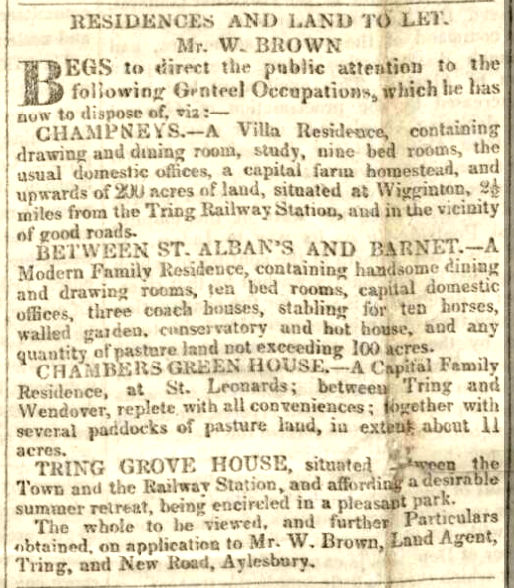 In 1841
William Brown advertised a number of
houses to let (see advert from the
Bucks Herald of 10th
October 1841)
including "Tring Grove House, situated between the Town and the
Railway Station, and affording a desirable summer retreat, being
encircled in a pleasant park" and Champneys. This could have
been vacant because Thomas Woodman (the auctioneer) had moved out. A year later it was
still vacant "with chaise house, stabling, large walled garden, and
small quantity of meadow land if desired." At various dates in the
1840s press references to the Tring Agricultural Show suggest that a Mr
J Somes was at
Tring Grove Farm and the
Herts Mercury of 22
July 1848 report a trial relating to the theft of barley from a
barn at Bulborne, the property of Mr
John Somes of
Tring Grove Farm.
There are also references to a Mr Southernwood of
Tring Grove Farm, the
earliest being to Thomas Southernwood winning a prize
for roots at the Tring Agricultural Association Show in the
Bucks Herald of 18th December 1841
and Herts Mercury of 25 December, 1841. In a
case involving the theft of hay in April 1844, reported in the
Herts Mercury of 6th July 1844, "Mr
Thomas Southernwood, of
Wilstone, deposed - that in April last he had hay in
Tring Grove Park
which was cut by the last witness [William Mole] ..." The following
year an advert for the Tring Agricultural Meeting in the
Bucks Herald of
11 October, 1845, reported that "The ploughing with two horses will
take place in Mr. Southernwood's field, adjoining the road from
Tring
Town to the station."
In 1841
William Brown advertised a number of
houses to let (see advert from the
Bucks Herald of 10th
October 1841)
including "Tring Grove House, situated between the Town and the
Railway Station, and affording a desirable summer retreat, being
encircled in a pleasant park" and Champneys. This could have
been vacant because Thomas Woodman (the auctioneer) had moved out. A year later it was
still vacant "with chaise house, stabling, large walled garden, and
small quantity of meadow land if desired." At various dates in the
1840s press references to the Tring Agricultural Show suggest that a Mr
J Somes was at
Tring Grove Farm and the
Herts Mercury of 22
July 1848 report a trial relating to the theft of barley from a
barn at Bulborne, the property of Mr
John Somes of
Tring Grove Farm.
There are also references to a Mr Southernwood of
Tring Grove Farm, the
earliest being to Thomas Southernwood winning a prize
for roots at the Tring Agricultural Association Show in the
Bucks Herald of 18th December 1841
and Herts Mercury of 25 December, 1841. In a
case involving the theft of hay in April 1844, reported in the
Herts Mercury of 6th July 1844, "Mr
Thomas Southernwood, of
Wilstone, deposed - that in April last he had hay in
Tring Grove Park
which was cut by the last witness [William Mole] ..." The following
year an advert for the Tring Agricultural Meeting in the
Bucks Herald of
11 October, 1845, reported that "The ploughing with two horses will
take place in Mr. Southernwood's field, adjoining the road from
Tring
Town to the station."
There is no statement about who bid for the various lots but in in a continuation of the Lake v Currie hearings in Chancery, reported in the Herts Guardian of 10th March, 1855, when it was said that "the estate sold, under direction of the Court, for £24,000, to a Mr. Butcher, one of the conditions being that the estate was subject to certain annuities ..." This sum must include Lot 1 (Grove Park Farm) and Lot 2 (Tring Grove Farm) and Mr Butcher is almost certainly the Mr. Thomas Butcher of Tring Bank. Two years later one of the witnesses in a bankruptcy hearing reported in the Herts Guardian of 12 August, 1856, was "William Kay of the Tring Grove Estate". [At the time William Kay junior owned Tring Park and after his death his property was acquired by Baron Rothchild.]
As to the occupants at the time of the sale, adverts relating to J Somes ended after 1854, and later in the decade there are references to a Mr Southernwood farming at Tring Grove in references to the Tring Agricultural Show. The accounts of the show in the Herts Guardian in 1856 also refer to "ploughing took place in a field of Mr. John Brown's adjoining the Kennels at Tring Grove.
Selected Census Returns
1851 - Tring Grove
| SOMES, John | Head | Married | M | 52 | 1799 | Farmer Of 320 Acres Employing 20 (Men) Labourers | Wollaston, Northamptonshire |
| SOMES, Elizabeth | Wife | Married | F | 48 | 1803 | Houghton Regis, Bedfordshire | |
| SOMES, Elizabeth | Daughter | Unmarried | F | 25 | 1826 | Farmer's Daur | Little Brickhill, Buckinghamshire |
| SOMES, Martha | Daughter | Unmarried | F | 20 | 1831 | Farmer's Daur | Gt Gaddesden, Hertfordshire |
| SOMES, Mary | Daughter | Unmarried | F | 14 | 1837 | Farmer's Daur | Tring, Hertfordshire |
| SOMES, Anne | Daughter | Unmarried | F | 12 | 1839 | Farmer's Daur | Tring, Hertfordshire |
| FLEET, Eliza | Servant | Unmarried | F | 19 | 1832 | House Servt | Ellesborough, Buckinghamshire |
| LAKE, Thomas | Servant | Unmarried | M | 16 | 1835 | Farm Servt | Wigginton, Hertfordshire |
| CRAWLEY, James | Servant | Unmarried | M | 14 | 1837 | Farm Servt | Wigginton, Hertfordshire |
1851 - Tring Grove
| SOUTHERNWOOD, Eleazer | Head | Married | M | 32 | 1819 | Farmer Of 120 Acres Employing 7 Labourers | Beaumonsleys, Leicestershire |
| SOUTHERNWOOD, Betsey | Wife | Married | F | 32 | 1819 | Buckland, Buckinghamshire | |
| SOUTHERNWOOD, Elizabeth | Daughter | F | 6 | 1845 | Scholar | Tring, Hertfordshire | |
| SOUTHERNWOOD, Eliza | Daughter | F | 1 | 1850 | Tring, Hertfordshire | ||
| ING, Elizabeth | Servant | Unmarried | F | 20 | 1831 | House Servant | Oakley, Buckinghamshire |
1861 - Tring Grove
| SOUTHERNWOOD, Eleazer | Head | Married | M | 42 | 1819 | Farmer Of 400 Acres Employing 18 Labourers And 10 boys | Beaumont, ... |
| SOUTHERNWOOD, Betsy | Wife | Married | F | 42 | 1819 | Buckland, Buckinghamshire | |
| SOUTHERNWOOD, Eliza | Daughter | F | 11 | 1850 | Tring, Hertfordshire | ||
| SOUTHERNWOOD, Mary A | Daughter | F | 8 | 1853 | Tring, Hertfordshire | ||
| SOUTHERNWOOD, Sarah H | Daughter | F | 7 | 1854 | Tring, Hertfordshire | ||
| SOUTHERNWOOD, Rosetta B | Daughter | F | 4 | 1857 | Tring, Hertfordshire | ||
| SOUTHERNWOOD, Catherine H | F | 2 | 1859 | Tring, Hertfordshire | |||
| GOUGH, Charlotte | Servant | Unmarried | F | 24 | 1837 | Cook | ... |
| ROWE, Mary A | Servant | Unmarried | F | 16 | 1845 | Housemaid | Wiggaton, Hertfordshire |
The lack of earlier references really reflects the limited information published in the earlier directories. The information on Thomas Woodman was recorded because there was the possibility of confusion between two different Thomas Woodman, and Dunsley Farm immediately adjoins Grove Park Farm.
1846 Directory
Somes John, farmer, Tring Grove
1851 Directory
Somes John, farmer, Tring Grove
Southernwood Eleazer, corn dealer & farmer, Tring Grove
Woodman Thomas, farmer, Dunsley Farm
1855 Directory
Somes John, farmer, Tring Grove
Southernwood Eleazer, farmer, Tring Grove
Woodman Thomas, farmer, Dunsley Farm
1866 Directory
Rance George, cattle dealer, Tring Grove
Southernwood Eleazer, farmer, Tring Grove
Woodman Thomas, farmer, Dunsley Farm
Tring Agricultural Association Book
As the Tring Agricultural Association Minute Book for the period exists it is appropriate to note relevant entries
In September 1853 "To balance received of Mr John Somes, the Late treasurer £6 14s 4d"
In the 1854 Show records a William Batchelor is recorded as having worked 39 years at Grove Farm and Mr Southernwood of Tring Grove entered a pen of 5 half-bred two-tooth wether sheep and a pen of 5 ewe lambs. For the years ploughing competition Mr Joseph Clarke and Mr Thomas Southernwood were appointed stewards.
In 1855 William Budd, shepherd to Mr. E. Southernwood had 217 lambs from 200 ewes (10 barren). Mr Eleazer. Southernwood of Grove Park also had two entries in the Swede Turnip competition, came first for White Round Turnips
In 1857 Mr E Southernwood of Tring Grove entered several classes for sheep
In 1858 E Southernwood is listed in the members of the Association, and a John Nutkins (aged 33) had worked on Tring Grove Farm for 25 years
In 1859 Mr E Southernwood attended a meeting of members in July
At the Show John Nutkins had done 26 years on Grove Farm (Mr E Sothernwood) Mr Southernwood of Tring Grove entered Swede turnip, mangold wurtzells, a field of swedes (2nd prize), field of Mangolds (1st prize) ewes, cart filly - Later proposed as steward
In 1860 Mr Eleazer Southernwood was steward for show yard and ploughing. He also won 2nd prize for Swede Turnip, 1st prize for Mangold wurtzells, prize for best cart filly
In 1861 Mr Eleazer Southernwood won the cup for the best cultivated root crop of at least 30 acres Brother Thomas of Wilstone cup for 5 acres of roots in farm with les than 60 acres in arable - prize for best wether lambs
Identification of the Properites sold
NOTE: A full identification of the properties will need an assessment of the surviving manuscript maps in various archives, which may show all or part of the estate, or show adjoining properties, which allow the boundaries to be be established.
|
Lots 1, 2, 3, 4, 5 These appear to be adjoining properties, approximately bounded in the North by the Ickneild Way through Bulbourne, in the West by Tring (Brook Street to New Mill), in the South by Dunsley Farm and Pendley. In the East the property reached and was cut by the canal but may not have reached the railway line, leaving Folly Farm between it and the boundary. |
|
%20Lot%201.jpg) |
Lot 1 Grove Park Farm Eleazer Southernwood (farmer of 120 acres employing 7 labourers) was farming here in 1851, his father Thomas, and later his brother Thomas, farming in Wilstone. By the time of the 1861 census he was also farming Tring Grove farm, and he is described as a farmer of 400 acres with 18 labourers and 10 boys.. It would seem that Grove Park Farm covered the area bounded by Brook Street, Grove Road and Station Road, and included the park area shown in the earliest maps. The advert said that the farm presented numerous eligible sites for first class houses and by 1861 just one house (Beech Grove) had been built on Station Road - occupied by William Brown, the auctioneer! |
%20Lot%202.jpg) |
Lot 2 Tring Grove Farm This was farmed in 1851 by John Somes of Tring Grove (farmer of 320 acres employing 20 labourers), who ended his links with the Tring Agricultural Association in 1853, and probably left the farm then, or shortly afterwards. He was probably in the farm by 1837 and was definitely there in 1841. It would seem that once John Somes had given up his tenancy the farm was combined with Grove Park Farm and run by Eleazer Southernwood (farmer of 400 acres ....) The dwelling house at Bulbourne (now used as a beer house) with stable attached and wharf, was undoubtedly what is now known as the Grand Junction Arms and in 1855 was occupied by Robert Faulkner, beer seller and wharfinger (described as coal merchant in 1851 census). The barn, stable, and shed surrounding a yard on the bank east of the canal was probably where the Canal Workshops were later built, and would be in the parish of Marsworth, Buckinghamshire. |
|
This map, pasted into the 1861 enumerators census book for the area, shows Grove Park Farm (highlighted) with the new house, Beech Grove, on the southern boundary. Tring Grove Farm is either side of the road through Marshcroft, but did not go as far as Folly Farm. |
|
%20Lot%203.jpg) |
Lot 3 Land by Canal at Bulbourne This could be the plot, on the other side of the road from the Grand Junction Arms, which currently has one house and about three acres in extent |
%20Lot%204.jpg) |
Lot 4 Marshcroft Cottage This might be the cottages shown at Marshcroft in the above sketch map, but it might also be the Pendley Cottages in the map. |
%20Lot%205.jpg) |
Lot 5 Cottages near Grove Park Farm Part of the Tring Grove hamlet. |
|
|
Lot 6 Picked Close Not identified |
%20Lot%207.jpg) |
Lot 7 Little Tring This must surely be the small farm in the loop of the Wendover Arm of the canal. The 1861 census records Henry Kinghorn, farmer of 40 acres employing 2 men and 1 boy. |
%20Lot%208.jpg) |
Lot 8 Dell's Wood Field Geary's Hill adjoins the road known was Wigginton Bottom. |
%20Lot%209.jpg) |
Lot 9 Farm at Wilstone This may well have been the farm of 101 acres occupied by the widow Mary Southernwood in the 1851 census. Eleazer Southernwood of Tring Grove was her son, and her husband was Mr Thomas Southernwood, of Wilstone, [who] had hay in Tring Grove Park in 1844. |
William Brown's Account Book basically recorded the act of selling a small estate, but was sufficient to identify press coverage of the sale. All the larger lots in the sale have been identified and the groundwork has been laid to make it possible to research a detailed history of the estate, at least up to the time Baron Rothschild purchased it.
It would seem that through much of the 18th century the Somes family were in residence in Grove Park Mansion, and the associated estate may well have included most of the area between Brook Street, Tring and the area where the canal and railway were later built, and between the Icknield Way and the Dunsley Farm and Pendley Estate. As the present road to the station was only built after the railway was opened in 1837 it cannot be assumed that the estate did not extend south of this road in places.
It would seem that an Edward Barker acquired the estate in 1799. Tring Grove Mansion House was offered to let in 1812, but had been demolished before the Bryant map was surveyed circa 1820. At some date before 1836 it was acquired by Viscount Lake, at a time when Thomas Woodman (auctioneer) was tenant of the Grove Park Farm. (It is interesting to note that cricket was played on this farm circa 1840 - could this be on the same field as the present day cricket club now has their pitch?)
It may well be that John Somes started farming Tring Grove Farm in the mid to late 1830s, while Thomas Woodman was in Grove Park Farm. The Southernwood family were already farming a detached part of the estate at Wilstone, and Eleazer Southernwood became the farmer, taking over both farms when John Somes gave up in 1853/4.
The two farms appears to have been brought by Thomas Butcher (or he may have been acting on behalf of the trustees of the William Kay estate) and later all the William Kay property in the area was acquired by Baron Rothschild.
As always research of this kind turns up more questions, and there is clearly much more that can be learnt from manuscript records and maps in various records offices. Some are routine (such as looking at land tax records to get exact dates for changes in owners and occupiers) but there are rogue topics which are really irrelevant but leave one wanting to know more. One such example relates to the news article by Garnett Jones - which leaves you wondering who the 50 people who emigrated to America in 1828 were!
As this was merely done to demonstrate the kind of information one might find at the start of research into an estate I have no immediate plans to take this further.
| September 2013 | Page Created |



.jpg)
.jpg)
.jpg)
.jpg)
